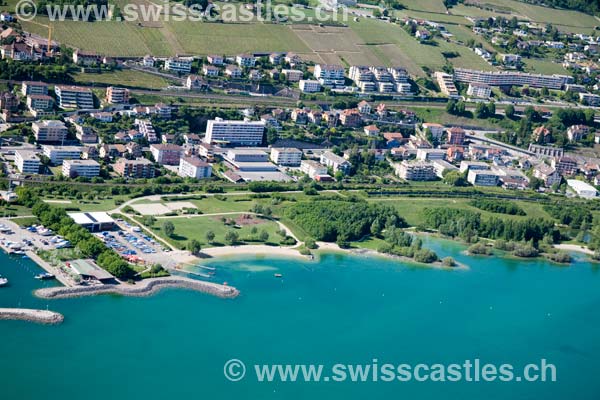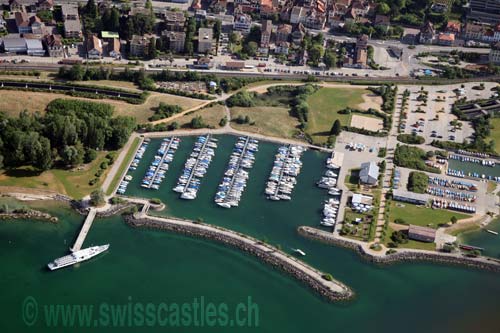Hauterive, Neuchâtel
Museum Laténium in Hauterive
Hauterive is a municipality in the district of Neuchâtel canton of Neuchâtel in Switzerland. The former German name Hauterive is no longer used today. After the merger of the former municipalities Freiburg Ecuvillens and Posieux to Hauterive ( FR) of the same neuenburgische community in 2001 officially in Hauterive ( NE) has been renamed.
Geography
Hauterive is located at 501 m above sea level. M., 4 km northeast of the capital of the canton of Neuchâtel (air line). The village is located on a terrace on the lower southern slopes of Chaumont, a scenic location about 70 m above the shore of Lake Neuchâtel.
The area of 2.1 km ² large municipality area includes a portion of the steep slope to the south of Chaumont. The communal land extends from the lake via the built-up and partly with vine -lined area the forested Jura south slope ( Côte d' Hauterive ) up to the edge of the height of Chaumont. This is where having 1,060 m above sea level. M. reached the highest point of Hauterive. From the municipality surface 1997 26 percent went to settlements, 59 percent of the forest and shrubs, 14 percent to agriculture and slightly less than one percent was unproductive land.
To Hauterive include the settlement Champréveyres, 440 m above sea level. M. along the main road near the lake. Neighboring communities of Hauterive are Neuchâtel and Saint -Blaise.
Geology
After Hauterive the geological epoch Hauterivian is named in the lower Cretaceous. The easily degradable, fine textured layer of rock ( pierre jaune de Neuchâtel ) was known by the Romans and was for the construction of Aventicum ( Avenches ) used. In the old town of Neuchâtel all buildings must be faced with this stone.
Population
With 2599 inhabitants ( 31 December 2012) Hauterive one of the larger municipalities in the canton of Neuchâtel. Of the 82.5 % inhabitants are French-speaking, German-speaking 6.2 % and 3.5 % Italian-speaking (as of 2000). Especially during the 1960s, significant population growth rates were registered.
Economy
Hauterive was once mainly a wine village, during the 20th century, it has developed into a residential community. Today, the built-up area of Hauterive is conjoined with that of the neighboring communities and Neuchâtel Saint -Blaise. At the optimally exposed to the sunny slopes on the north shore of Lake Neuchâtel is operated Viticulture ( wine region Champréveyres ).
Traffic
The community is conveniently moderately well developed. It lies on the main road 5 from Biel to Neuchatel and on the A5 motorway. On 7 November 1859, the railway line from Neuchatel to Le Landeron opened with a station in Saint -Blaise, whose western part is located in the municipality of Hauterive. In addition Hauterive is served by the public transport company Transports en commun de Neuchâtel et environs, this is done by the line 7 of Neuchâtel trolleybus.
History
On the shores of Lake Neuchâtel traces of settlement have been found from the Neolithic period and the Bronze Age ( stilt houses ). During Roman times, the partly paved road Vy d' Etra ran through the municipality.
The first written mention of the village under the name Alta Ripa dated to the year 1143, when the Fontaine-André Abbey was founded. The monks cultivated the wine and talked for a wine press. Hauterive included in the County of Neuchâtel. Since 1648 Neuchâtel principality and 1707 was linked by personal union with the Kingdom of Prussia. 1806, the region was ceded to Napoleon I. and came in 1815 during the Congress of Vienna to the Swiss Confederation, the kings of Prussia until 1857 Neuchâtel trade also prince of Neuchâtel remained.
In memory of Maurice Bavaud a stele in Hauterive was built in 2011. Bavaud had tried before the 2nd World War, to shoot Adolf Hitler in Munich. But he was arrested, tortured and beheaded in 1941.
Attractions
At the village square which is in the core from the 15th century three-storey former school house with arcades. In the village there are more old patrician houses, including the House Court in 1577 and built in the 17th century house Clottu.
Also known is the 2016 Gallery, where works of contemporary artists. Directly on the lake lie the archaeological park and the Cantonal Museum Laténium.
Personalities
- Maurice Bavaud (1916-1941), assassination attempt against Hitler
- Yann Richter (1928-2008), politician, party president and National










